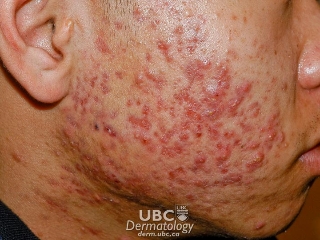The information in this section has been gathered from existing peer-reviewed and other literature and has been reviewed by expert dermatologists on the CSPA Medical Advisory Board.
Acne occurs when dead skin cells block the openings of oil and hair follicles, called pores, and trap oil that is naturally produced by the body, called sebum (pronounced see-bum). This leads to increased growth of bacteria within the pores and inflammation. The combination of trapped skin cells and sebum can lead to the formation of whiteheads and blackheads, while the inflammation leads to pimples and cysts on the face, back, scalp, shoulders, arms and/or chest.
Acne is a very common skin disorder and is the one most often seen by doctors in skin patients. Although not life-threatening, acne can cause temporary or sometimes permanent marks on the skin, which can affect a person’s self-esteem and quality of life.
 Acne example
Acne example  Acne Example 2
Acne Example 2  Acne Example 3
Acne Example 3  Acne Example 4
Acne Example 4
While there is no way to accurately predict who will develop acne, you are more likely to experience a severe form of it if one of your parents did, or if you suffer from certain diseases or particular hormonal abnormalities (such as polycystic ovary syndrome or Cushing’s syndrome).
What causes acne?
Acne is linked to the hormone testosterone, which occurs naturally in both sexes. One of the many effects of increased testosterone levels is to stimulate the skin’s oil glands to produce sebum, an oily substance that helps to moisturize the skin. The oil glands lie in the skin’s middle layer, wrapped around hair shafts. Where the shaft extends up to the skin’s surface, this tubular structure is called a follicle.
Overactive oil glands pump large amounts of sebum upward through ducts along the hair shaft to the skin’s surface, where it fills up the follicle and overflows onto the skin. At the same time, the dead skin cells lining the follicle are not shed properly and clog up the follicle. That’s when blackheads and whiteheads begin to appear. Blackheads develop when the blockage is incomplete and air oxidizes the oil, leading to a darkened residue. When the follicle is completely blocked, no air comes into contact with the oil, which then maintains its pale white appearance.
Clogged follicles set up ideal conditions for a common resident follicle bacteria, Propionibacterium acnes (P. acnes), to multiply rapidly inside the follicle, leading to the next stage of acne—what most people call pimples, or “zits.” Various substances released by the P. acnes bacteria provoke local inflammation in the follicle, causing redness, swelling and sometimes tenderness. Doctors call these red bumps papules. When the centres of the papules have a large build-up of inflammatory cells and pus, these blemishes are called pustules. Sometimes, the follicle wall will burst, leading to larger and deeper areas of inflammation, called nodules. The body’s immune system response is to enclose these materials in fluid-filled sacs, called cysts. Both nodules and cysts can be quite painful and can lead to scarring if left untreated.











